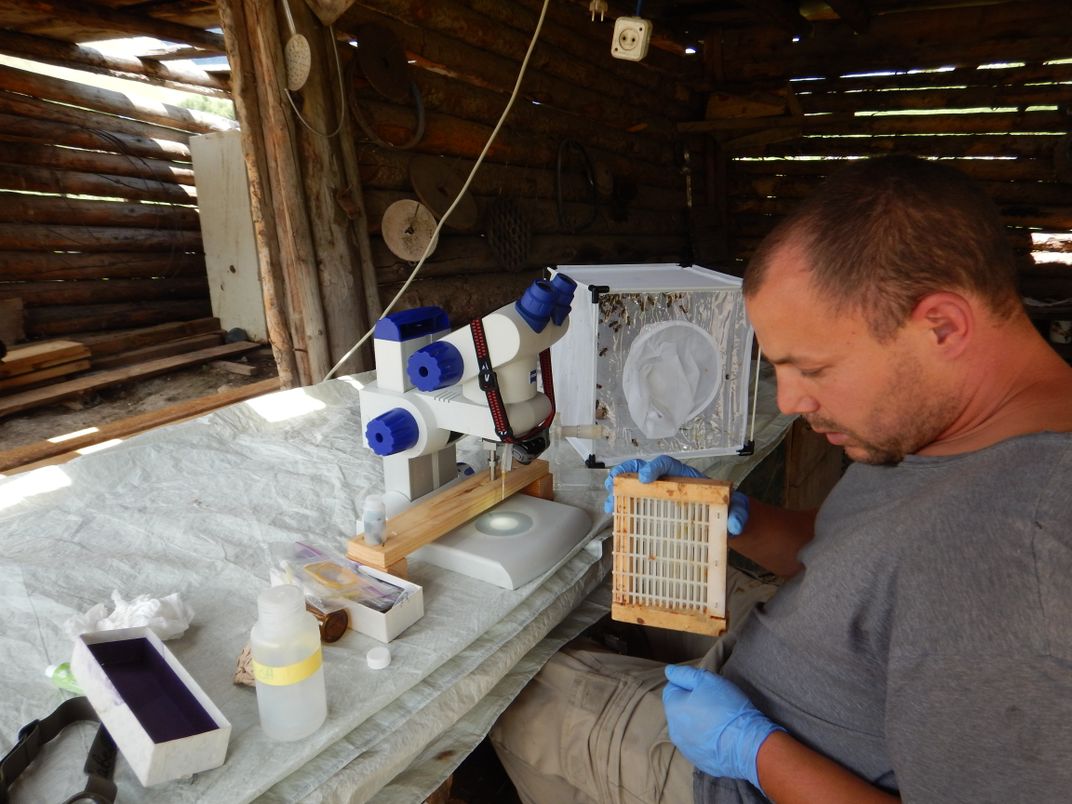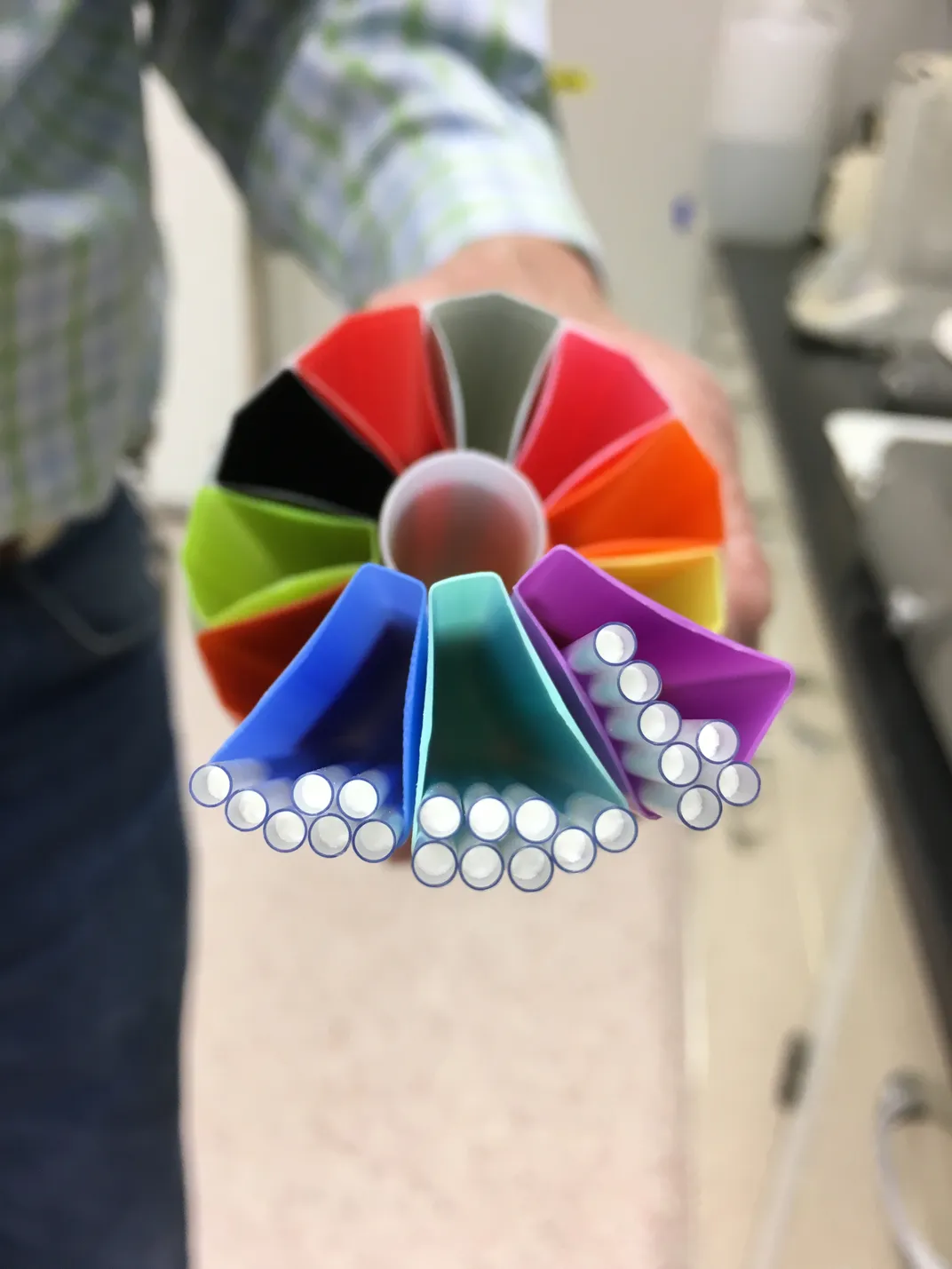Is the Key to Saving Pollinators … Honey Bee Semen?
In the hopes of preserving their genetic diversity, entomologists are collecting and freezing this valuable fluid
/https://tf-cmsv2-smithsonianmag-media.s3.amazonaws.com/filer/87/0b/870b0dae-dde9-42e2-9708-8f9491b33566/mm8241_140915_10538_crop.jpg)
The first question everyone wants to know is: how?
“I’m surprised it took you so long to ask,” Brandon Hopkins says with a laugh. The 35-year-old entomologist is preparing samples to be sent to the USDA Agricultural Research Service National Laboratory for Genetic Resources Preservation in Fort Collins, Colorado, a facility dedicated to securing our food supply by collecting genetic material from agricultural species. “You pretty much just squeeze them, and the stuff pops out,” he says.
Hopkins is the apiary and lab manager of Washington State University’s Apiary Program, and the “stuff” he’s referring to is honey bee semen.
Yes, semen. Hopkins spends a lot of his time visiting beekeepers and collecting seminal fluid from drones, the male honey bees that exist primarily to impregnate queen bees. Or, as Hopkins puts it: “They’re flying genitalia. They don’t collect nectar; they don’t collect pollen. The only thing they do is mate.”
He prefers to capture drones during flight, when they are on their way back from their daily attempts to mate with a queen. Between 1 and 5 p.m.—their flight time—he sets mesh screens in front of the entrances to hives. Worker bees are small enough to get through the screens and back into their dwelling, but drones can’t. As they cling to the dividers, Hopkins springs into action, gathering the stinger-less bees in cages and placing them, one by one, under the microscope.
He explains his process: “When you squeeze a male, if he’s mature, his genitalia pops out. And then, floating on a bit of mucus, is about one microliter of semen.” Sadly, in nature, drones put so much blood and energy into reproduction that they die after successful mating. And this is what Hopkins mimics in the lab: “We squeeze them to the point where they die,” he says. It takes Hopkins about an hour to process 300-500 drones and fill a single 100-microliter tube with their reproductive fluid.
The follow-up question, of course, is: why? That is: why in the world are scientists collecting bee semen?
In short, as a hedge for the future. “There could be unique and valuable [variants of a gene] that may not be noticeably valuable at this point,” but could become incredibly important in the face of a yet-unknown future threat, Hopkins says of the genetic material he collects. Most of the semen is frozen, catalogued and stored in Fort Collins, where the hope is that it will stay viable for years, perhaps decades, just waiting to be thawed out so it can impregnate a honey bee far in the future.
Or not so far in the future. Honey bees already face plenty of threats: pests and diseases, pesticides and fungicides, nutrition and the way colonies are managed, both in terms of beekeeping and breeding and genetics. Topping the list is a parasitic mite called Varroa destructor, which reproduces in honey bee colonies and lives up to its sinister name by sucking the blood from adults and developing larvae. It has been devastating bee populations since it was first detected in the United States in 1987.
By the numbers, the situation is dire. According to the USDA National Agricultural Statistics Service, in the late 1940s, we had nearly 6 million managed beehives in the United States. By 2008, that number dropped to just over 2 million—and has stayed there ever since. The semen Hopkins collects, then, could help protect, or even expand, future generations of honey bees—which means safeguarding billions of dollars in agricultural crops and an inestimable wealth of biodiversity for the planet.
.....

While the United States is home to around 4,000 native bees, our agricultural pollinator of choice is the non-native honey bee, which hails from South and Southeast Asia. That’s because honey bees are prolific and multipurpose pollinators, says Bob Danka, the research leader of the USDA Honey Bee Lab in Baton Rouge, Louisiana. While some bees pollinate a single species of plant, honey bees forage on over 100 commercial crops, delivering nearly $3,000 worth of pollination services per hectare per crop.
In the U.S., honey bees handle “something like 90 percent of pollination,” Danka explains, and one colony averages a peak summer population of upwards of 60,000 bees. “Other bees can’t exist in large enough numbers to pollinate vast acreages of crops,” he says. The bees can also be moved in and out of various locations with relative ease, which is essential for crops like almonds, which require cross-pollination.
Between February and March of each year, 80 to 90 percent of the country’s available commercial bees—about 1.8 million colonies—are trucked to California to pollinate almond blossoms. But the work doesn’t end there. These bees are used year-round for their labor, writes Ferris Jabr writes in Scientific American:
“After the almond bloom, some beekeepers take their honeybees to cherry, plum and avocado orchards in California and apple and cherry orchards in Washington State. Come summer time, many beekeepers head east to fields of alfalfa, sunflowers and clover in North and South Dakota, where the bees produce the bulk of their honey for the year. Other beekeepers visit squashes in Texas, clementines and tangerines in Florida, cranberries in Wisconsin and blueberries in Michigan and Maine. All along the east coast migratory beekeepers pollinate apples, cherries, pumpkins, cranberries and various vegetables. By November, beekeepers begin moving their colonies to warm locales to wait out the winter: California, Texas, Florida and even temperature-controlled potato cellars in Idaho.”
This overreliance on honey bee labor, however, has its dangers. “We, in North America, have painted ourselves into this corner using honey bees because of modern agricultural practices and our need to produce large amounts of crops efficiently,” Danka says. And the work is starting to stress the bees out: “The pressure on them is very real, and it seems to be getting worse.”
Today, you might think of these bees as fully dependent on humans. “When Varroa mites came to the U.S., it eliminated 99 percent of the feral population of honey bees,” Hopkins says. "Some are saying there are no wild honey bees now because they can’t survive without human intervention. They’re like a domestic species.”
This codependent relationship with humans is revealed in changes in bee nutrition. Bees are just like us: They need a varied diet in order to thrive. As our diets have become less diverse, so have theirs. The expansion of industrialized agriculture and increase in monocrops grown in monoculture means there is little diversity in the plants from which bees source pollen and nectar. The habitats where they forage have turned into what Marla Spivak, a professor of entomology at the University of Minnesota, describes as “food deserts.”
The challenge is exacerbated, Spivak explains in a 2012 TED talk, by the convergence of supply and demand. At the same time we’re experiencing a decline in bee populations, we’re also growing an increasing number of crops that rely on them. In the last half-century, she says in her talk, "there has been a 300 percent increase in crop production that requires bee pollination.” Just last year, American beekeepers lost approximately 40 percent of their honey bee colonies.
.....

That’s why, in 2016, the USDA’s Agricultural Research Service decided to add honey bee semen to its Fort Collins collection, which also stores a range of other materials—from seeds and stems to animal blood and embryos—that are essential for sustaining our domestic food supply. “It is part of [our] response to the ongoing crisis that the country’s beekeepers are facing,” the institution wrote in its online post announcing the launch.
The man tasked with the glamorous job of collecting the semen? Brandon Hopkins.
In 2008, the modern-day honey bee sperm collector was wrapping up a master’s degree in biology at Eastern Washington University focusing on the reproductive biology of frogs and mice. When Hopkins learned about the challenges bee populations were facing, however, he decided to explore a method that has been used to preserve the semen of cows and other animals: cryogenic freezing. Traditionally, bee semen specimens were extracted, stored at room temperature and stayed viable for about two weeks.
“I had never even really seen a honey bee hive,” Hopkins says. “But, fortunately, my master’s advisor had been [working] long enough in the mammalian world—with cattle and sheep and goats and all that stuff—and he said, ‘It doesn’t have to be perfect, it just has to work.’ Rather than waiting to get a perfect system, we went ahead and did it.”
In fact, Hopkins explains, they set about freezing honey bee semen despite the fact that one of the last papers written about cryopreservation from the 1980s stated the results weren’t good enough and that researchers should stop pursuing that method of storage. Nevertheless, Hopkins extracted a single capillary tube of semen (100 microliters), froze it and had “pretty good success.”
This was happening at the same time that Washington State University researcher Steve Sheppard, head of the WSU Apis Molecular Systematics Laboratory, was out in the field, collecting fresh material of the same variety. That year, he had been awarded the only permit given by USDA to import semen from global bee populations into the United States. Those samples became the foundation of what has become the largest collection of bee germplasm in the world, stored at WSU and containing subspecies native to Europe, Western Asia and Central Europe.
Sheppard subsequently became Hopkins’ PhD advisor, and the two of them started traveling together, collecting bee semen and freezing it on-site. The work came with unique challenges. “The problem with fresh semen is that you only get that one shot,” Hopkins explains. “It’s very expensive and time-consuming to collect overseas. Then you use it and may have a queen that doesn’t even produce any progeny.”
But it also paid off: Hopkins says the material collected and frozen five years ago is “the same as if it had been frozen for five days.”
When asked if he ever envisioned this as his life’s work, Hopkins was clear: “No. For sure not.” But he sees the incredible value in the work he's doing. “The cool thing about the incorporation of cryopreservation in bee breeding is that it will allow us to breed across space and time,” Sheppard said in an email. “We can retrieve genetics years after it’s been placed in storage. So, you can envision that, in 2030, we could cross the bees back to material from 2015 that we have [stored] in the liquid nitrogen tank.”
And that’s why it’s important to preserve material that’s both commercially viable and diverse. “While I don’t really think that we’re going to suddenly lose all our honey bees and need to tap into this frozen stock to repopulate the planet with bees, it is too bad that we weren’t doing this before, say, Varroa mites came,” Hopkins says. “We lost a huge amount of genetic diversity in the U.S. population that we can’t really get back because we didn’t have any frozen material.”
To get back to that level of diversity, he says, there is more work to be done. “Honey bees are an agricultural domestic species now,” says Hopkins. “They need the same research and attention that cattle, for example, get. It would be great if they were better recognized—in conservation, breeding techniques, selection, all [it takes] to improve them.”

